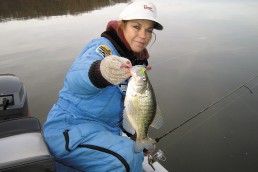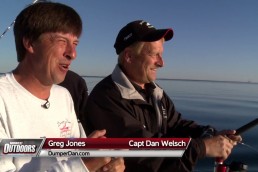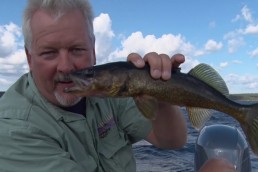It’s Coldwater Fishing
SHARE THIS POST
This past fall we had some pretty good crappie and white bass fishing. As I’m writing this, the crappies have moved into shallower water and the whites have moved into some of the creeks and bigger coves chasing shad on the shallow flats.
They should still be in these same areas in January, and easy to catch, if we still have open water. January’s patterns are pretty hard to predict in advance because the water temperatures—once well above freezing in fall—can drop with a typical prolonged winter cold snap.
Temperatures aren’t the only reason whether the open water freezes or not.
We’ve had a couple of pretty good rainfalls, so the lake level has come up some and right now. Again, as I’m writing, the lake is actually a little above summer pool. The Corps at some point will want to get the level down to winter pool, which is 6 feet below summer pool, to allow for spring rains. Depending on how fast they try to drop it, it could create a little current in the rivers and creeks, which will help keep it from freezing. Also, even if the water is cold, wind and wave action can help to keep it open.
As you probably know, Shelbyville is a Corps of Engineer lake and it’s also a flood control lake that was formed by damming the Kaskaskia River, which also flows through and forms Lake Carlyle downstream and eventually flows into the Mississippi River south of St. Louis. The Corps office in St. Louis governs our lake levels. And the level of the Mississippi determines whether we let water flow through Shelbyville or hold it back in Shelbyville. That’s the reason for a summer and winter pool level.
We always hope for, and sometimes have open water all year, and if we do, a lot of us use our boats and fish right through winter, thanks to the availability of good, warm clothing.
By January, most local anglers now have turned to crappie fishing whether it’s from a boat or through a hole in the ice.
Are you enjoying this post?
You can be among the first to get the latest info on where to go, what to use and how to use it!
If we have open water we’ll fish for crappies much like we did in November and December. We’ll look for some type of cover in the water. It may be a downed tree, a stump, brush pile, beaver hut or even rock riprap. We use tube jigs on 1/16-ounce lead heads and work them in and around the cover. Bites this time of year can be pretty subtle, so you really have to watch your line to detect bites and also know if your bait’s close to a snag. If you pay attention and “stay in contact” with your jig, you’ll catch more fish and avoid getting hung up in the cover.
Even though we prefer tube jigs, many will work, as well as minnows. It’s just a matter of preference.
You may have to try several places and types of cover to find the fish or “better” fish. If you’re catching mostly small fish, go try another place until you find an area holding bigger fish. Sometimes we have to resort to putting the jig below a bobber at a determined depth and fish around stumps or standing timber so we can work the bait slowly around the cover at a set depth.
On Lake Shelbyville, you can keep 10 crappies over 10 inches and five under 10 inches for a limit of 15 per person.
If the lake is frozen, make sure it’s thick enough to be safe. On a lake this size, some areas will have thicker ice than others.
Either way, dress warm enough so you can enjoy being out.
MWO
SHARE THIS POST
Did you enjoy this post?
You can be among the first to get the latest info on where to go, what to use and how to use it!
Mary Satterfield
Lifelong angler Mary Satterfield is a retired professional bass angler, and has she held titles of National and World Champions and Angler of the Year. She’s run the multispecies Eagle Creek Guide Service on Lake Shelbyville since 1989. She may be contacted at: 217-756-3299.



